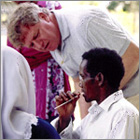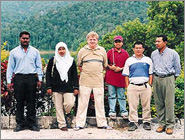Scientific Papers |
Single, Rapid Coastal Settlement of Asia Revealed by Analysis of Complete Mitochondrial Genomes
by Vincent Macaulay et al
This recent paper published in 'Science' by Vincent Macaulay and an international team of researchers including Professor Stephen Oppenheimer of Green College, Oxford, and a member of the Bradshaw Foundation Advisory Board, provides irrefutable evidence of the early timing and southern location of the only migration out of Africa to succeed and give rise to all modern non-African peoples. The paper states that all non-Africans descend from a single group of humans that left Africa by a coastal route across the mouth of the Red Sea to South Asia
This disproves current theories - which argue for several successful exits via different routes and at different times, including a direct northern route to Europe 45,000 years ago.
One or more exits from Africa? North .v. South
A commonly held view has been that modern humans left Africa both round the north and the south of the Red Sea in several waves to populate Europe and Asia. New analysis of genetic trees in isolated ‘relic’ populations on the trail in Southeast Asia by Oppenheimer and others now overturns that orthodoxy. The research shows that there was only a single dispersal from Africa, via a southern coastal route, across the mouth of the red Sea, through India and onward into Southeast Asia and Australasia. There was subsequently a northern offshoot from the Gulf region, leading ultimately to the settlement of the Near East and Europe, but this only occurred much later.
The key to this new and detailed story of our migration is mitochondrial DNA [mtDNA]. MtDNA passes from mother to child, each generation, unchanged, therefore every person alive on the Earth today has inherited this small collection of genes from one single great-great-great-grandmother, nearly two hundred thousand years ago. There are occasional mutations in the mtDNA molecule, enabling the tracing of migrations of people. This trail of maternal inheritance is backed up by the Y-chromosomes passed only down the male line. The mtDNA and Y trees each show only one branch coming out of Africa, implying only one exit.
The key findings in ‘OUT OF EDEN’, all now supported by the research published this week in SCIENCE, are:
There was one exodus from Africa via an earlier southern route 60 to 80 thousand years ago that led to the peopling of the rest of the planet.
Modern humans only reached Europe the long way round, via Southern Arabia, with this retarded movement into Europe taking place approximately 50,000 years ago.
Malaysian tribes provide a living link to the route pursued east after the exodus across the Red Sea, as modern humans beachcombed their way to Australia over several thousand years.
Early Europeans were not the first to learn to paint, carve, develop complex culture and speak, and do not represent a major biological advance. Evidence indicates that humans must have arrived in India already painting and fully ‘modern’.
Bradshaw Foundation
Vincent Macaulay, Catherine Hill, Alessandro Achilli, Chiara Rengo, Douglas Clarke, William Meehan, James Blackburn, Ornella Semino, Rosaria Scozzari, Fulvio Cruciani, Adi Taha, Norazila Kassim Shaari, Joseph Maripa Raja, Patimah Ismail, Zafarina Zainuddin, William Goodwin, David Bulbeck, Hans-Jurgen Bandelt, Stephen Oppenheimer, Antonio Torroni, and Martin Richards.
Abstract
A recent dispersal of modern humans out of Africa is now widely accepted, but the routes taken across Eurasia are still disputed. We show that mitochondrial DNA variation in isolated "relict" populations in southeast Asia supports the view that there was only a single dispersal from Africa, most likely via a southern coastal route, through India and onward into southeast Asia and Australasia. There was an early offshoot, leading ultimately to the settlement of the Near East and Europe, but the main dispersal from India to Australia 65,000 years ago was rapid, most likely taking only a few thousand years.
Click to read abstract
Two further papers from the same issue of 'Science':
Kumarasamy Thangaraj, Gyaneshwer Chaubey, Toomas Kivisild, Alla G. Reddy, Vijay Kumar Singh, Avinash A. Rasalkar, and Lalji Singh
Abstract
The origin of the Andaman "Negrito" and Nicobar "Mongoloid" populations has been ambiguous. Our analyses of complete mitochondrial DNA sequences from Onges and Great Andaman populations revealed two deeply branching clades that share their most recent common ancestor in founder haplogroup M, with lineages spread among India, Africa, East Asia, New Guinea, and Australia. This distribution suggests that these two clades have likely survived in genetic isolation since the initial settlement of the islands during an out-of-Africa migration by anatomically modern humans. In contrast, Nicobarese sequences illustrate a close genetic relationship with populations from Southeast Asia.
Click to read abstract
Peter Forster and Shuichi Matsumura
Abstract
When the first early humans ventured out of Africa, which way did they go? Studies of maternally inherited mitochondrial DNA are revealing the excursion choices of our earliest ancestors. In their Perspective, Forster and Matsumura discuss two new studies of the mitochondrial DNA of the indigenous peoples of Malaysia and the Andaman islands (Macaulay et al., Thangaraj et al.). These studies suggest that the earliest humans took a southern route along the coastline of the Indian Ocean before fanning out over the rest of the world.
Extract from Forster & Matsumura
In Europe, Neanderthals were replaced by modern humans only about 30,000 to 40,000 years ago, whereas southern Australia was definitely inhabited 46,000 years ago and northern Australia and Southeast Asia necessarily even earlier (9, 10). Or did our ancestors instead depart from East Africa, crossing the Red Sea and then following the coast of the Indian Ocean (11)?
References:
9. G. Barker, Asian Perspect.44, 90 (2005).
10. J.M. Bowler et al., Nature421, 837 (2003).
11. S. Oppenheimer, Out of Eden (Constable, London, 2003).
by Vincent Macaulay et al
| Stephen Oppenheimer contributes to 'Science' magazine paper on 'Out of Africa' 13/5/05 Science 2005 308: 1034-1036 (see abstract below) Photographs by Freda Oppenheimer |
 |
 |
This recent paper published in 'Science' by Vincent Macaulay and an international team of researchers including Professor Stephen Oppenheimer of Green College, Oxford, and a member of the Bradshaw Foundation Advisory Board, provides irrefutable evidence of the early timing and southern location of the only migration out of Africa to succeed and give rise to all modern non-African peoples. The paper states that all non-Africans descend from a single group of humans that left Africa by a coastal route across the mouth of the Red Sea to South Asia
This disproves current theories - which argue for several successful exits via different routes and at different times, including a direct northern route to Europe 45,000 years ago.
 |
 |
The paper endorses the claims and new conclusions made by Stephen Oppenheimer 2 years ago in his 2003 book ‘Out of Eden’ [‘The Real Eve’ in the USA], the material of which was used in the Channel 4 programme of the same name, the Discovery Channel film ‘The Real Eve’, the BBC series ‘The Incredible Human Journey’, and in the Bradshaw Foundation’s Journey of Mankind Genetic Map. |
One or more exits from Africa? North .v. South
A commonly held view has been that modern humans left Africa both round the north and the south of the Red Sea in several waves to populate Europe and Asia. New analysis of genetic trees in isolated ‘relic’ populations on the trail in Southeast Asia by Oppenheimer and others now overturns that orthodoxy. The research shows that there was only a single dispersal from Africa, via a southern coastal route, across the mouth of the red Sea, through India and onward into Southeast Asia and Australasia. There was subsequently a northern offshoot from the Gulf region, leading ultimately to the settlement of the Near East and Europe, but this only occurred much later.
The key to this new and detailed story of our migration is mitochondrial DNA [mtDNA]. MtDNA passes from mother to child, each generation, unchanged, therefore every person alive on the Earth today has inherited this small collection of genes from one single great-great-great-grandmother, nearly two hundred thousand years ago. There are occasional mutations in the mtDNA molecule, enabling the tracing of migrations of people. This trail of maternal inheritance is backed up by the Y-chromosomes passed only down the male line. The mtDNA and Y trees each show only one branch coming out of Africa, implying only one exit.
The key findings in ‘OUT OF EDEN’, all now supported by the research published this week in SCIENCE, are:
There was one exodus from Africa via an earlier southern route 60 to 80 thousand years ago that led to the peopling of the rest of the planet.
Modern humans only reached Europe the long way round, via Southern Arabia, with this retarded movement into Europe taking place approximately 50,000 years ago.
Malaysian tribes provide a living link to the route pursued east after the exodus across the Red Sea, as modern humans beachcombed their way to Australia over several thousand years.
Early Europeans were not the first to learn to paint, carve, develop complex culture and speak, and do not represent a major biological advance. Evidence indicates that humans must have arrived in India already painting and fully ‘modern’.
Bradshaw Foundation
| Single, Rapid Coastal Settlement of Asia Revealed by Analysis of Complete Mitochondrial Genomes by Vincent Macaulay et al |
Vincent Macaulay, Catherine Hill, Alessandro Achilli, Chiara Rengo, Douglas Clarke, William Meehan, James Blackburn, Ornella Semino, Rosaria Scozzari, Fulvio Cruciani, Adi Taha, Norazila Kassim Shaari, Joseph Maripa Raja, Patimah Ismail, Zafarina Zainuddin, William Goodwin, David Bulbeck, Hans-Jurgen Bandelt, Stephen Oppenheimer, Antonio Torroni, and Martin Richards.
Abstract
A recent dispersal of modern humans out of Africa is now widely accepted, but the routes taken across Eurasia are still disputed. We show that mitochondrial DNA variation in isolated "relict" populations in southeast Asia supports the view that there was only a single dispersal from Africa, most likely via a southern coastal route, through India and onward into southeast Asia and Australasia. There was an early offshoot, leading ultimately to the settlement of the Near East and Europe, but the main dispersal from India to Australia 65,000 years ago was rapid, most likely taking only a few thousand years.
Click to read abstract
Two further papers from the same issue of 'Science':
| Reconstructing the Origin of Andaman Islanders |
Kumarasamy Thangaraj, Gyaneshwer Chaubey, Toomas Kivisild, Alla G. Reddy, Vijay Kumar Singh, Avinash A. Rasalkar, and Lalji Singh
Abstract
The origin of the Andaman "Negrito" and Nicobar "Mongoloid" populations has been ambiguous. Our analyses of complete mitochondrial DNA sequences from Onges and Great Andaman populations revealed two deeply branching clades that share their most recent common ancestor in founder haplogroup M, with lineages spread among India, Africa, East Asia, New Guinea, and Australia. This distribution suggests that these two clades have likely survived in genetic isolation since the initial settlement of the islands during an out-of-Africa migration by anatomically modern humans. In contrast, Nicobarese sequences illustrate a close genetic relationship with populations from Southeast Asia.
Click to read abstract
| Evolution: Did Early Humans Go North or South? |
Peter Forster and Shuichi Matsumura
Abstract
When the first early humans ventured out of Africa, which way did they go? Studies of maternally inherited mitochondrial DNA are revealing the excursion choices of our earliest ancestors. In their Perspective, Forster and Matsumura discuss two new studies of the mitochondrial DNA of the indigenous peoples of Malaysia and the Andaman islands (Macaulay et al., Thangaraj et al.). These studies suggest that the earliest humans took a southern route along the coastline of the Indian Ocean before fanning out over the rest of the world.
Extract from Forster & Matsumura
In Europe, Neanderthals were replaced by modern humans only about 30,000 to 40,000 years ago, whereas southern Australia was definitely inhabited 46,000 years ago and northern Australia and Southeast Asia necessarily even earlier (9, 10). Or did our ancestors instead depart from East Africa, crossing the Red Sea and then following the coast of the Indian Ocean (11)?
References:
9. G. Barker, Asian Perspect.44, 90 (2005).
10. J.M. Bowler et al., Nature421, 837 (2003).
11. S. Oppenheimer, Out of Eden (Constable, London, 2003).
